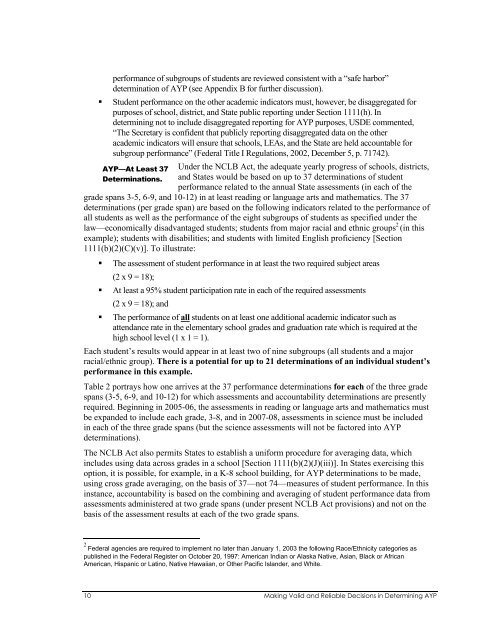MAKING VALID AND RELIABLE DECISIONS IN ... - CCSSO projects
MAKING VALID AND RELIABLE DECISIONS IN ... - CCSSO projects
MAKING VALID AND RELIABLE DECISIONS IN ... - CCSSO projects
Create successful ePaper yourself
Turn your PDF publications into a flip-book with our unique Google optimized e-Paper software.
performance of subgroups of students are reviewed consistent with a “safe harbor”determination of AYP (see Appendix B for further discussion).Student performance on the other academic indicators must, however, be disaggregated forpurposes of school, district, and State public reporting under Section 1111(h). Indetermining not to include disaggregated reporting for AYP purposes, USDE commented,“The Secretary is confident that publicly reporting disaggregated data on the otheracademic indicators will ensure that schools, LEAs, and the State are held accountable forsubgroup performance” (Federal Title I Regulations, 2002, December 5, p. 71742).Under the NCLB Act, the adequate yearly progress of schools, districts,and States would be based on up to 37 determinations of studentperformance related to the annual State assessments (in each of thegrade spans 3-5, 6-9, and 10-12) in at least reading or language arts and mathematics. The 37determinations (per grade span) are based on the following indicators related to the performance ofall students as well as the performance of the eight subgroups of students as specified under thelaw—economically disadvantaged students; students from major racial and ethnic groups 2 (in thisexample); students with disabilities; and students with limited English proficiency [Section1111(b)(2)(C)(v)]. To illustrate:AYP—At Least 37Determinations.The assessment of student performance in at least the two required subject areas(2 x 9 = 18);At least a 95% student participation rate in each of the required assessments(2 x 9 = 18); and The performance of all students on at least one additional academic indicator such asattendance rate in the elementary school grades and graduation rate which is required at thehigh school level (1 x 1 = 1).Each student’s results would appear in at least two of nine subgroups (all students and a majorracial/ethnic group). There is a potential for up to 21 determinations of an individual student’sperformance in this example.Table 2 portrays how one arrives at the 37 performance determinations for each of the three gradespans (3-5, 6-9, and 10-12) for which assessments and accountability determinations are presentlyrequired. Beginning in 2005-06, the assessments in reading or language arts and mathematics mustbe expanded to include each grade, 3-8, and in 2007-08, assessments in science must be includedin each of the three grade spans (but the science assessments will not be factored into AYPdeterminations).The NCLB Act also permits States to establish a uniform procedure for averaging data, whichincludes using data across grades in a school [Section 1111(b)(2)(J)(iii)]. In States exercising thisoption, it is possible, for example, in a K-8 school building, for AYP determinations to be made,using cross grade averaging, on the basis of 37—not 74—measures of student performance. In thisinstance, accountability is based on the combining and averaging of student performance data fromassessments administered at two grade spans (under present NCLB Act provisions) and not on thebasis of the assessment results at each of the two grade spans.2 Federal agencies are required to implement no later than January 1, 2003 the following Race/Ethnicity categories aspublished in the Federal Register on October 20, 1997: American Indian or Alaska Native, Asian, Black or AfricanAmerican, Hispanic or Latino, Native Hawaiian, or Other Pacific Islander, and White.10 Making Valid and Reliable Decisions in Determining AYP







